Peeling the onion that is this 2013 NASCAR stocker
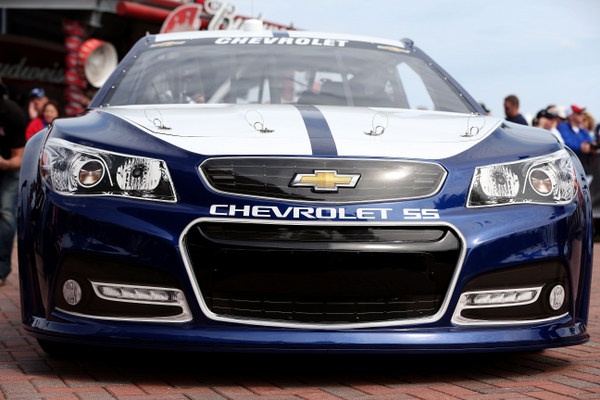
Looks like a big ol' grin (Photo: Getty Images for NASCAR)
By Mike Mulhern
mikemulhern.net
DAYTONA BEACH, Fla.
More of the story behind the story of the NASCAR 2013s is slowly being revealed, and it's quite intriguing.
Surprisingly perhaps, since the Chevy SS was the last of the new models to come fully out to the spotlight, this story, as NASCAR president Mike Helton says, started with Chevrolet.
In fact it started right at the top of General Motors.
With Mark Reuss, the president.
And what we have here now is a full-blown NASCAR race car...in search of street car production and dealership marketing.
(It will be curious to gauge the interest from GM's 'sampling' of fans about the new car in the Chevy fan zone display just outside the fourth turn.)
GM's Mark Reuss, the man who made it happen (Photo: Getty Images for NASCAR)
Saturday night's shootout was the first major test of the three 2013 stockers, and there was general parity. The only serious complaint being heard is by Ford crews complaining about the 'louvered' grill.
"All three OEMs had cars that could run up front, and all three had cars that could come from the back to the front," Chevrolet's Pat Suhy says. Suhy is GM Racing's NASCAR technical group manager.
"Now Daytona 500 qualifying is to me the ultimate test of aero performance. Watching them race in a pack doesn't tell you as much about the basics, or the fundamentals of the car."
If so, Chevy may be ready to run the table here: five of the six fastest 500 qualifiers are in Chevys. Danica Patrick, Jeff Gordon, Ryan Newman, Tony Stewart and Kasey Kahne.
The queen for a day, at least (Photo: Getty Images for NASCAR)
Much of the story here, though, appears to be 'Race car begets street car.'
The new Chevy stock car itself really came first...
And NASCAR racing, after all, is marketing for Detroit.
Yes, the SS is based on the Australian Holden Commodore series, and Ford's Fusion appears based in part on the Aston Martin DB9.
But the push is clear -- to race something that you can sell.
Now this SS is not quite in the league of those outlandish Detroit winged cars of the 1970s, mind you.
Much more subtle.
To look at the street model SS unveiled here, almost stealthy-staid in silver, well, you might easily overlook it in a parking lot.
But look more closely....
Kevin Harvick: first win for a new 2013 (Photo: Getty Images for NASCAR)
One point, the SS is Chevrolet's first rear-wheel-drive big-body car since the 1996 Caprice and Impala. Virtually all race cars are rear-wheel-drive, but most street cars are front-wheel-drive, for fuel economy. RWD street cars offer much better performance, which is why BMW, Mercedes, Corvette, Camaro, Mustang, Charger, Aston Martin, and other performance cars are RWD.
GM's Australia Holden branch is the company's top RWD production operation, which is why the SS will be built there. (Reuss ran Holden for several years, before moving to Detroit.)
Chevy men are billing the new SS as their version of the BMW-5 series. "With more performance," one says. And at a cheaper price than the 5's $48,000 to $70,000.
Just how to market this SS, and how to position it, appears still in discussion.
Ford got the jump on Chevy and Toyota with its 2013....but some in the Ford camp are now complaining about those grill louvers (Photo: Getty Images for NASCAR)
Chevrolet's NASCAR-oriented engineering department has long been famous for its R&D side, with people fiddling around with 'what-ifs' and 'how-can-we.'
The development of various Chevy stock car engines over the years is one clear example. First, the R&D guys come up with a project and tweak into a NASCAR-something, and then they politic NASCAR for it. Anyone who followed the long evolution of the R07 engine and the SB2 will be familiar with this.
(And with word of a new NASCAR 'engine of tomorrow' project looming, it's likely Chevrolet is busy with the yellow legal pads. "In terms of technology," one engine man says with a laugh, "we've finally caught up with the 1990s.)
So a couple of years after the car-of-tomorrow hit the tracks, to much disdain and added engineering work, Chevy engineers began another R&D project. The thesis was basic: what things would we all really like to have in a race car?
Generally, just design a new NASCAR stocker with the bells and whistles teams and drivers would really like.
It wasn't a damn-the-torpedoes-full-speed-ahead project. Just a slowly evolving series of ideas, maybe really more an academic exercise than anything, beginning sometime in 2009. That was some two years into NASCAR's car-of-tomorrow.
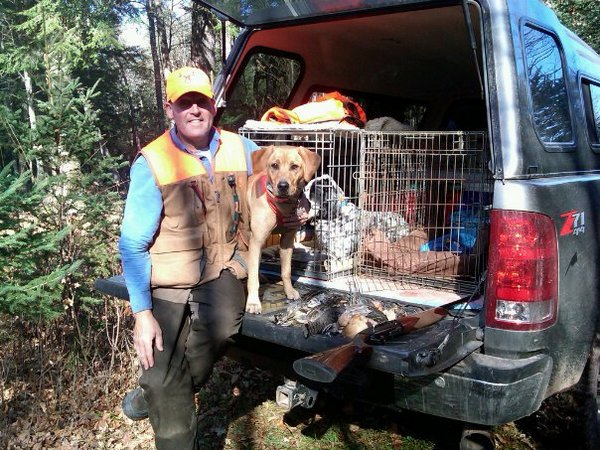
Chevy racing engineer Pat Suhy: NASCAR point man (Photo: Pat Suhy)
But it was looking good enough that somewhere along the line the engineers brought the project to Reuss' attention.
Now Reuss, as president of General Motors (also the son of former GM president Lloyd Reuss), is the top dog.
And the company at this time was going through those economic throes that roiled the GM waters everywhere.
Reuss, and this may seem almost incredulous, given the typically slow pace of things at the giant auto maker, took a look at the project, said he liked what he saw, and issued the command "Go do it. Get it done."
The engineers were amazed.
They took the project to NASCAR, notorious for its no's unless a project originates in Daytona. But Chevy engineers were armed with the command from the man at the very top. "He said 'I don't care what you were thinking; this is what we're doing.' It was great to have that direction," Suhy says.
"We took out a clean sheet of paper and said 'Let's get out of our comfort paradigm and see what we can do.'"
Chevy team owners Tony Stewart and Richard Childress, clowning around (Photo: Getty Images for NASCAR)
And NASCAR listened...and agreed...and told the engineers to take their project to an even more technically advanced level.
Of course when the president of General Motors gives the okay to a NASCAR project, it just makes sense to say yes.
More? Do more?
NASCAR, remember, when not saying no, tends to put tight limits on things, very tight limits.
More?
The engineers now were stunned.
They went back to the drawing boards and started adding even more tweaks.
The 2013 time table?
In May of 2010 the four NASCAR car makers all sat down with NASCAR officials for the first time all together. NASCAR laid out some ground rules for the four, but then generally left things up to the four: "You OEMs go out and figure it out, and keep us in the loop and let us know what's going on," Suhy said.
So success or failure here rests largely on Chevy, Ford and Toyota.
When Chevy engineers began design work, there was no street car really yet to work with. No dealership passenger car.
The Chevy SS, which Reuss and his execs rolled out here Saturday afternoon in the infield of Daytona International Speedway, was, at the beginning, a science project that would eventually have to become a marketing project.
And that marketing project is still just getting under way.
How much will the dealership model cost? When can you buy one and drive it off the lot?
TBD.
Rather than -- classically -- taking a street car and turning it into a race car, Chevrolet was creating a race car that it would somehow eventually have to turn into a street car.
"The passenger car was in process," Suhy insists. "We actually used map-data from the passenger car to create the race car.
"There might have been a clay model of it in Warren, Mich....though we didn't see it until after we'd built our prototype.
"We designed the (race) car just like we would design a production car. And we just pushed and shoved the production car's math around to fit over the Gen-6 chassis."
It appears that Chevrolet was more aggressive in this 2013 project than its NASCAR rivals. The others, Suhy says, may have been waiting, as they did in the COT project, "'for some lines on paper, and rules, so we don't have to keep doing and re-doing.'"
Chevrolet, particularly the Rick Hendrick camp, got out front in the early days of the COT and that played to an advantage.
Suhy says that may be the case here again. "We saw the benefit of being in on the ground floor, so to speak.
"Before NASCAR knew what it wanted to do, how far it wanted to let us go, we built that first car.
"That did a couple of things for us. It showed Mark Reuss and others what we could do to design a race car. And when we showed it to NASCAR, and they pushed us to go even further, that was so cool. It was great.
"I just wonder if we had all waited and not done that first car, until NASCAR really put some lines on paper, I don't know what we would have ended up with."
One of the benefits of this grand 2013 project, Suhy says, is a new sense of camaraderie among the car makers, who have had to work together, really for the first time like this.
"Back in the day we didn't talk to each other; I didn't know what Ford was doing, and I didn't care what Ford was doing, I was just paying attention to our interests," Suhy says.
"Now we've learned that there is a certain amount of shared interest, that we have to communicate at least, and for our mutual benefit we have to find some common ground.
"This project is a great example of that."
Good business partners here: NASCAR president Mike Helton (L) and General Motors president Mark Reuss (Photo: Getty Images for NASCAR)
© 2010-2011 www.mikemulhern.net All rights reserved.
Web site by www.webdesigncarolinas.com







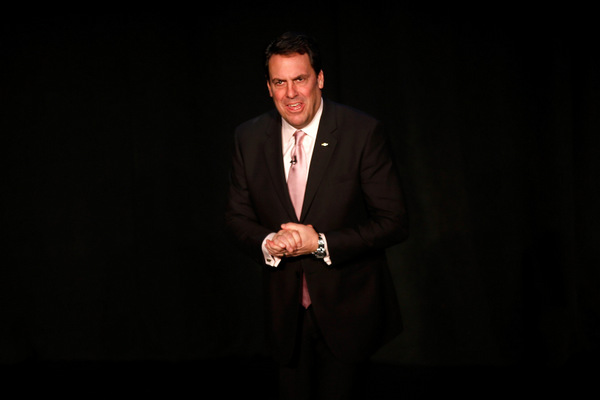
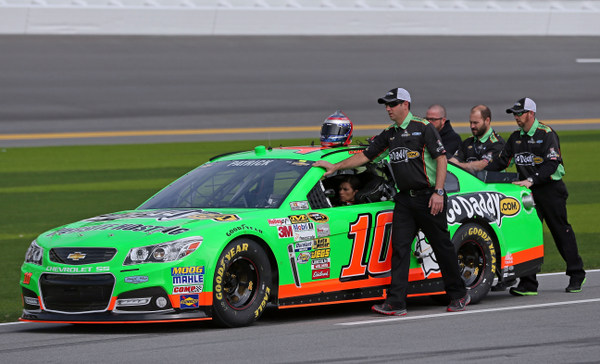
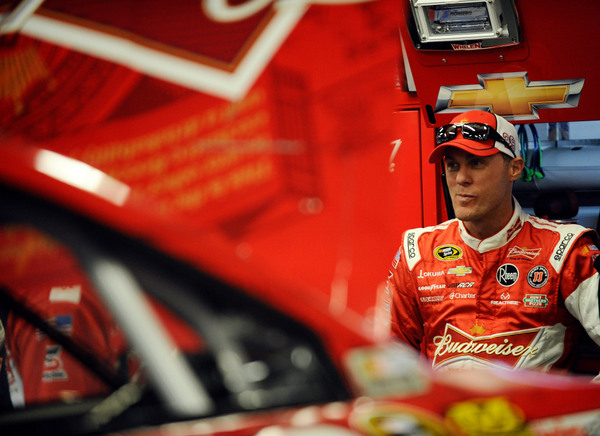
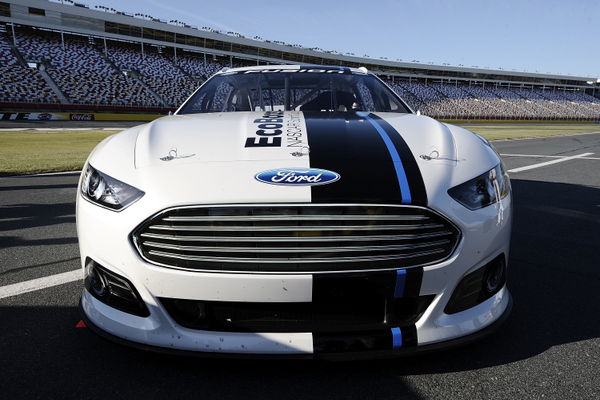
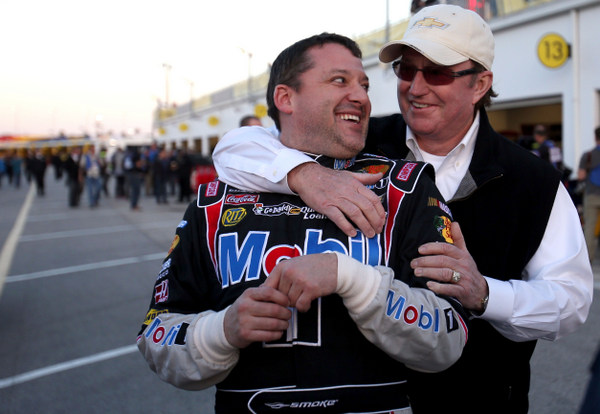
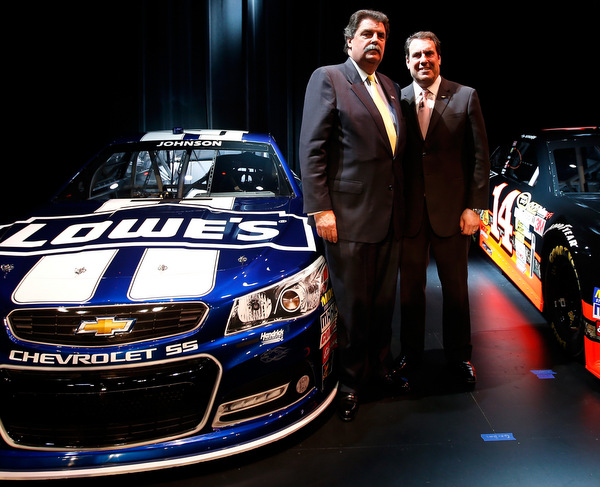
Manufacturer Camaraderie
Between NASCAR\'s surprising lack of involvement in the development of these new cars and the outright camaraderie between the manufacturers, this story gets stranger. But the overall approach still shows some needed changes, namely racecars that are not the top-heavy sedans the sport has been racing; instead it\'s long past time to get back to long-snout, lean, raked-roofline aerocoupes - that model is stable as opposed to these machines.
With the manufacturers now more in tune with each other, maybe now they can start addressing the sport\'s absurd spending levels and lack of controls in such areas.
NASCAR
The Daytona race was a disappointment for several reasons. First my fav brand i.e. the fords were slow just like they were the last few years, despite what the stats say. I do not pay too much attention to stats and only agree with the big white dyno. That is a reference to Bonneville salt flats land speed record and I am comparing Daytona to Bonneville it being a long track requiring hp. Anyway does anyone have any gossip or better the facts as to why are the fords lacking hp/slow? Aero? Drivers have said the cars were slow in pratice and qualifying and the race was a disaster for ford debuting the new gen 6 cars and a Ford that is striving for brand ID at NASCAR. Yeah it was a ford that got beat by a Chevy and was behind both the superb fast Chevy’s and Toyota’s the entire race! How embarrassing for me a ford guy !!! Time to start looking at other brands I think. And I am not the only one that highly noticed the beautiful FAST Chevy SS running mile long circles around the dog of the Fords all of them!
Post new comment